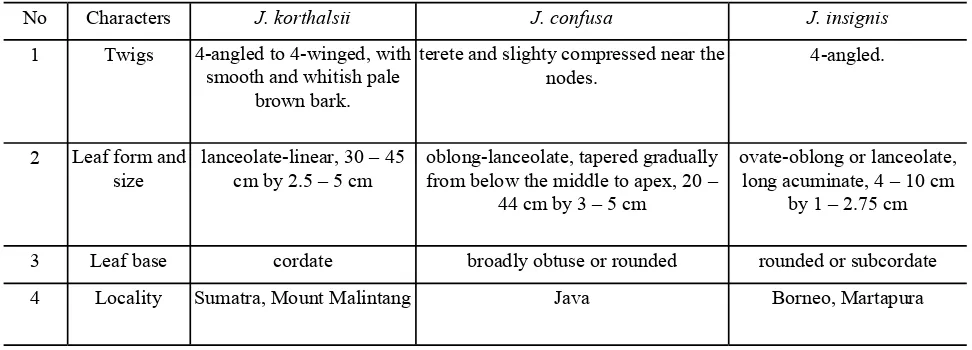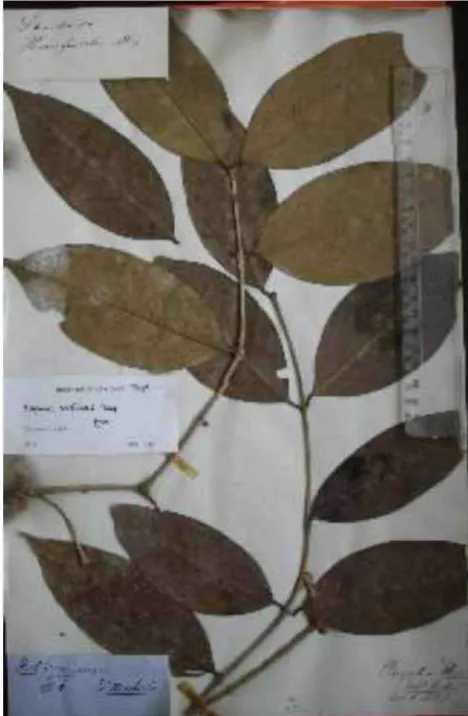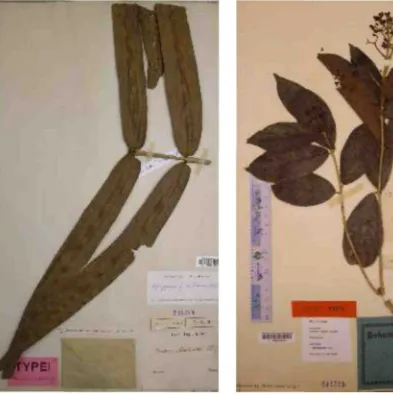REINWARDTIA
A JOURNAL ON TAXONOMIC BOTANY,
PLANT SOCIOLOGY AND ECOLOGY
Vol. 13(3): 221 —315, April 11, 2012
Chief Editor
KARTINI KRAMADIBRATA
Editors
DEDYDARNAEDI (INDONESIA)
TUKTRIN PARTOMIHARDJO (INDONESIA) JOENI SETIJO RAHAJOE (INDONESIA) TEGUHTRIONO (INDONESIA)
MARLINAARDIYANI (INDONESIA) EIZI SUZUKI (JAPAN)
JUN WEN (UNITED STATE OF AMERICA)
Managing editor
HIMMAH RUSTIAMISecretary
ENDANG TRI UTAMI
Lay out
DEDEN SUMIRATHIDAYAT
Illustrators
SUBARIWAHYUDI SANTOSO ANNE KUSUMAWAIY
Reviewers
BRYAN SIMON (AUSTRALIA), EVE J. LUCAS (UNITED KINGDOM), J.F.VELDKAMP (NETHERLANDS), LAUR-ENCE SKOG (USA), PIETER BAAS (NETHERLANDS), RUTH KIEW (MALAYSIA), ROBERT J. SORENG (USA), HE-LENA DUISTERMAAT (NETHERLANDS), LYN A. CRAVEN (AUSTRALIA), RUGAYAH (INDONESIA), MARK HUGHES (UNITED KINGDOM), MARTIN CALLMANDER (USA), PETER C. VAN WELZEN (NETHERLANDS), WAYNE TAKEUCHI (USA), NOBUYUKI FUKUOKA (JAPAN).
Correspondence on editorial matters and subscriptions for Reinwardtia should be addressed to:
HERBARIUM BOGORIENSE, BOTANY DIVISION,
RESEARCH CENTER FOR BIOLOGY-LIPI,
CIBINONG 16911, INDONESIA
REINWARDTIA Vol 13, No 3, pp: 235 − 240
235
young floral buds, persistent and conspicuous bracteoles, and a seed coat which adheres to the pericarp in Eugenia. Recent molecular evidence supports a scenario in which these two genera are in fact independent lineages (Biffin, 2005; Widodo, 2010).
Direct observation and comparison of all type specimens cited below, as well as of extensive material of Eugenia from the New World, allows the following nomenclatural transfers to be made with confidence.
SYZYGIUM Gaertn.
Syzygium Gaertn., Fruct. Sem. Pl. 1(1788) 166, t. 33, f. 1, nom. cons. –Eusyzygium Miq., Fl. Ned. Ind. 1, 1(1855) 447, nom. inval. – Lectotype: Syzygium caryophyllaeum
Gaertn. (typ. cons.), Ceylon, designated by McVaugh (1956). [= Syzygium caryophyllatum (L.) Alston, pro specim. Ceylon. Eugenia auct. non L. (1753); M.R. Hend., Gard. Bull. Singapore 12 (1949)16; Kochummen, Tree Fl. Malaya 3 (1978)172.
Jambosa Adans., Fam. Pl. 2 (1763) 88, 564, orth. cons. (‖Jambos‖, orth. rej.); Rumph. ex DC., Prodr. 3 (1828)
286, isonym. – Eugenia L. subgen. Jambosa (Adans.) Benth. in Benth. & Hook. f., Gen. Pl. 1(1865) 718. –
Eugenia L. sect. Jambosa (Adans.) F. Muell., Fragm. Phytogr. Austral. 5 (1865), nom. inval.; Boerlage, Handl. Fl. Ned. Indië 1, 2 (1890) 497. – Eugenia L. sect.
Eujambosa Nied. in Engl. & Prantl., Nat. Pflanzenfam. 3, 7 (1893)83, nom. inval. – Type: Jambosa vulgaris DC., INTRODUCTION
Syzygium is an entirely Old World genus. In Indonesia and its surrounding areas, many Syzygium species were originally described in Eugenia L. or Jambosa Adans. The generic circumscriptions of Eugenia, Jambosa, Syzygium and some minor satellite genera has had a troubled history with authors frequently transferring species between genera. Alston (1931) reduced Jambosa Adans. (1763) to the synonymy of Syzygium and the former name is now treated as a nomen rejiciendum. The generic concepts of Niedenzu (1893) and Diels (1922) were largely followed by Merrill and Perry (1939) and Ashton (1981) who included in Syzygium not only those Old World species with calyptrate petals (Syzygiums.s.) but also most of the other Old World species with free petals (Jambosa). Generally, this concept has been adopted by the majority of subsequent taxonomists, with the exception of Henderson (1949), and Kochummen (1978), who treated all species as Eugenia s.l., creating significant taxonomic uncertainty.
Taxonomic confusion in Eugenia and Syzygium resulted from the considerable overlap of macro- and micro-morphological characters. Currently it is clear that these genera are significantly different. Detailed analysis by Schmid (1972) showed thedifferences between Eugenia and Syzygium included the evident pubescence of the
NEW NOMENCLATURE IN SYZYGIUM (MYRTACEAE) FROM
INDONESIA AND ITS VICINITIES
Received September 29, 2010; accepted August 01, 2011
PUDJI WIDODO
Departemen Biologi, Institut Pertanian Bogor, Bogor, Indonesia. Permanent Address: Fakultas Biologi, Universitas Jenderal Soedirman, Jl. Dr. Soeparno 63, Purwokerto 53122, Indonesia. Email: [email protected]
ABSTRACT
WIDODO, P. 2012. New nomenclature in Syzygium (Myrtaceae) from Indonesia and its vicinities. Reinwardtia 13(3): 235−240. ― Current generic concepts in Myrtaceae suggest that nearly all Old World taxa originally described in
Eugenia L. and Jambosa Adans. should be accommodated within Syzygium P. Br. ex Gaertn. Six new combinations and a new name in Syzygium are proposed. Complete synonymy and typifications are given.
Keywords: Eugenia s.l., Jambosa, Myrtaceae, new combinations, Syzygium, taxonomy.
ABSTRAK
WIDODO, P. 2012. Tatanama baru pada Syzygium (Myrtaceae) dari Indonesia dan kawasan sekitarnya. Reinwardtia 13 (3): 235−240. ― Konsep generik pada jambu-jambuan (Myrtaceae) saat ini menunjukkan bahwa hampir semua taksa dari Dunia Lama yang semula dipertelakan dalam Eugenia L. dan Jambosa Adans. harus dimasukkan ke dalam
Syzygium P. Br. ex Gaertn. Enam kombinasi baru dan satu nama baru dalam Syzygium diusulkan. Sinonimi dan tipifikasi lengkap disajikan.
REINWARDTIA
Cybrootes 7103 (Holotype: K!).
Small tree, glabrous. Twigs terete and compressed, canaliculated. Leaves elliptic- lanceolate, acuminate cuspidate, 12.5–15 cm long, 4.5–5 cm wide; greenish brown above and yellow-ish brown beneath when dry; leaf base long attenuate or cuneate, subcoriaceous, apex shortly acuminate; venation horizontally paralleled, 30 pairs of veins; petiole slender, 1.5–2 cm long, dark brown to black when dry; midrib depressed, elevated beneath; 12.5–15 cm long, 4.5–5 cm wide; petiole 1 cm long; intramarginal vein 1 mm from margin. Inflorescence a few flowered cyme, usually two per leaf axis and subterminal; peduncle ca. 2 calyptrate; stamens up to 20.
Notes. This is a small tree in undergrowth of mature forests. It is remarkable for the numerous parallel
Basionym: Jambosa celebica Blume, Mus. Bot. 1 (1850) 107. – Eugenia celebica (Blume) Merr., Interpr. Herb. Amboin. (1917) 397. – Type: Celebes, Tondano Herb. Lugd. Bat.Sheet No 898.203- 317 & 318 (Holotype: L!).
A tree, height unknown. Twigs terete and compressed below nodes, drying yellowish. Leaves opposite, elliptic-oblong, 10–19 cm long, 3.8–8.25 cm wide; dark purplish brown above and paler below when dry; petiole slender, 0.5–10 mm long, canaliculate above, convex beneath, black when dry; leaf base cuneate, apex acuminate; major lateral veins 6–9 pairs, nerves confluent curved in the intramarginal vein; coriaceous without glandular dots; intramarginal vein 2–5 mm from margin. Inflorescence axillary; peduncle terete, short, drying yellowish; few flowered, subsessile; pseudostipe very short or none; calyx tube subcampanulate, the limb disk-shaped or circular, short, 4-lobes, subequal; corolla subincurved. Stamen numerous,
filament filiform. Ovary 2-locules, multiovule.
3. Syzygium horsfieldii (Miq.) Widodo comb. nov.
Basionym: Jambosa horsfieldii Miq., Fl. Ned. Ind. 1(1) (1855)420. – Eugenia horsfieldii K. et V. – Type: Java, Surakarta, Horsfield T No 6(Holotype: K!). ― Fig. 2.
A tree, size unknown. Twigs slightly 4-angled, and compressed below nodes, pale brown or grayish when dry. Leaves subopposite, elliptic or elliptic-oblong, acuminate, 10–15.2 long, 4.5–7 cm wide; drying brown above and pale brown below; petiole slender, 4–7 mm long, black when dry, subtereted when young, canaliculated when young, leaf base acute; elliptic or elliptic-oblong; base obtuse– rounded, apex acuminate, glandular dotted, punctuate; midrib pale brown when dry; major lateral veins 6–10 pairs; intramarginal veins 3–5 mm from margin. Inflorescence terminal, few flow-ered (or solitary?); pedicel short (ca. 25 mm long); pseudostipe very short or none; calyxes short, calyx tube campanulate, base short, conspicuously constricted to peduncle junction; lobe 4, inequal.
4. Syzygium korthalsii Widodo, nom. nov.[non S. lanceolatum (Lam.) Wight & Arn., 1834]. ― Fig. 3.
Basionym:Jambosa lanceolata Korth. ex Miq., Fl. Ned. Ind. 1(1) (1855) 426; Ned. Kruidk. Arch. 1 (1846)199. – straight near intramarginal veins; minor lateral veins absent or present, oil dots between 2 major lateral veins a few or less than 20 per cm2; intramarginal
vein 1 or 2, faint, 1–3 mm from margin. Inflorescence not seen; flower with a pseudostipe 5
–7 mm long; hypanthial cup funnel-shaped; sepals triangular, 5–6 mm long, 5 mm wide; petals not seen; style 35 mm long. Fruits not seen.
2012] WIDODO: New nomenclature in Syzygium (Myrtaceae) from Indonesia and its vicinities 237
reaching approximately 45 cm long, and only around 3.5 cm wide in average. Korthals (1846) described Jambosa lanceolata based on his collection from the forests of Mt. Malintang
(―Melintang‖), W. Sumatra, Indonesia. Blume
(1850) incorrectly concluded that this was a mixed collections, and proposed the names J. confusa Blume for material from Java: Blume s.n. (holo: L! sheet no 898.203-342), J. insignis Blume for that from Borneo: Korthals s.n. holo: L! (sheet no 898.203-347), and J. korthalsii Blume for the original collections from Mt. Malintang: Korthals s.n. (Holo L! sheet no 898.203-346). An additional specimen examined is Teijsmann 840 HB (BO!).He
also suggested that Korthals‘s name was
superflu-ous, as there was already a J. lanceolaria, based on Eugenia lanceolaria Roxb. (1832). Actually, Blume made it himself right here under J. korthalsii. These epithets are similar, but do not mean the same thing [lanceolarius = small (tip of a) spear; lanceolatus = lancet-shaped], and are not confusable under the
ICBN. Contrary to Blume‘s opinion, Jambosa korthalsii therefore is a superfluous name and it is Jambosa lanceolata that stands as the correct name that now requires transferral to Syzygium. Currently in Syzygium the combination S. lanceolatum (Korth.) is taken by S. lanceolatum (Lam.) Wight & Arn. (1834). I therefore here propose a new name
using Blume‘s illegitimate epithet as is allowed
under Art. 58.1 of the ICBN (McNeill et al., 2006).
5. Syzygium suave (Ridl.) Widodo comb. nov.
Basionym: Eugenia suavis Ridl., J. Fed. Malay States-surface dark green, light green beneath; leaf drying grayish above and pale brown below; petiole slender, 10–15 mm long, canaliculate above, pale to dark brown when dry; base acuminate or obtuse, apex acuminate. Major lateral veins 9–14 pairs. Intramarginal vein 1–2 mm from margin. Flowers accented whitish. Peduncle branches and pedicel sharply 4-angled, pale brown when dry; hypanthial cup narrowly to broadly funnel-shaped; pseudostipe short or none. Calyxes yellowish white, especially the latter red tinged. Corolla white, stamen white, anthers yellow.
6. Syzygium sumatranum (Miq.) Widodo comb. nov. ― Fig. 4.
Basionym: Jambosa sumatrana Miq., Fl. Ned. Ind. 1(1) (1855) 419. – Type: Sumatra, upper Angkola, Junghuhn s.n.,Herb. Lugd. Bat No 898.203- 374 & 376 (Holotype: L!).
A tree, size unknown. Twigs subterete, and slightly 4-angled-compressed below nodes, pale brown when dry. Petioles canaliculate, slender 4–6 mm long, yellowish brown when dry. Leaves opposite sometimes subopposite; elliptic or oblong sub abrupt acuminate, 7.5–13 cm long, 3.5–5.8 cm rarely axillary; peduncle terete, yellowish when dry. Flowers usually sessile; calyxes turbinate-clavate 2
– 4 mm long, subequal, when young.
7. Syzygium valetonianum (King) Widodo comb. nov.
Basionym: Eugenia valetoniana King, J. Asiat. Soc.
Ben-No Characters J. korthalsii J. confusa J. insignis
1 Twigs 4-angled to 4-winged, with smooth and whitish pale
brown bark.
terete and slighty compressed near the nodes.
3 Leaf base cordate broadly obtuse or rounded rounded or subcordate
REINWARDTIA than a crow-quill, terete, the bark pale brown, flaky. Leaves elliptic–oblong, 7–10 cm long, 3–4 cm wide; both surfaces dark purple to blackish when dry; base cuneate-obtuse, apex acuminate or obtuse; petiole slender 10–15 mm long, canaliculate above, brown when dry; major lateral veins 8–12 pairs; intramarginal vein 1–2 mm from margin. Inflorescence terminal or axillary, paniculate, shorter than the leaves, with very short, terete, few flowered cymose branches, or in a small pedunculate cymes; peduncle terete, blackish when dry. Flowers sessile, calyxes ca. 7.5 mm long, hypanthial cup clavate-campanulate, constricted into a short pseudostipe; the wide mouth truncate, or with 4-deciduous, short, rounded lobes. Petals small, orbicular, deciduous. Fruits when unripe pyriform, when ripe globular, crowned by the wide calyx-limb, ca. 12 mm long.
Notes. A species close to E. griffithii, and also close to E. clarkeana, and E. koordersiana, but with much smaller panicles and fruit at first pyriform.
ACKNOWLEDGEMENTS
I have been supported by a grant from the Directorate General of Higher Education, the Republic of Indonesia. I would like to thank Prof. Dr. Alex Hartana, Prof. Dr. Mien A. Rifai, and Dr. Tatik Chikmawati for advice. Herbarium Bogoriense (BO), National Herbarium of Netherlands (L) and Herbarium Kewense (K) are thanked for permission to study the collections deposited in these institutions. My special thanks to Prof. Peter van Welzen (L) for assistance and for critically reviewing some pa-pers. I would like to express my gratitude to Dr. Jan-Frits Veldkamp (L) for assistance and advice. To Lyn A. Cra-ven (CANB) and Prof. John Parnell (TCD) for advice
ASHTON, P. S. 1981. Myrtaceae. In M.D. Dassanayake,
A revised handbook to the Flora of Ceylon 2: 403– 473. Smithsonian Institution & National Science Foundation, Washington (DC). Pflanzengeschichte und Pflanzengeographie. 57: 356 –426.
HENDERSON, M. R. 1949. The genus Eugenia
(Myrtaceae) in Malaya. Gardens’ Bulletin Singapore
12: 1–293.
KOCHUMMEN, K. M. 1978. Eugenia. In F.S.P. Ng,
Tree flora of Malaya 3: 172–247. Longman, London. KORTHALS, P. W. 1846. Jambosa lanceolata Korth.
Ned. Kruidk. Arch. 1:199.
MCNEILL, J., BARRIE, F. R., BURDET, H. M., DE-MOULIN, V., HAWKSWORTH, D. L., MARHOLD, K., NICOLSON, D. H., PRADO, J., SILVA, P. C., SKOG, J. E., WIERSEMA, J. H. & TURLAND, N. J. 2006. International Code of Botanical Nomenclature (Vienna Code). (Regnum Vegetabile 146). Gantner, Ruggell, Liechtenstein, xviii + 568 p. URL: http:// ibot.sav.sk/icbn/main.html
MERRILL, E. D. & PERRY, L. M. 1939. The Myrtaceous genus Syzygium Gaertner in Borneo.
Mem. Amer. Acad. Arts 18 (3): 135–202. Reprinted in Mem. Gray Herb. Harvard Univ. 4.
NIEDENZU, F. 1893. Myrtaceae. In A. Engler and K. Prantl, Die natürlichen Pflanzenfamilien 3, 7: 78–86. Engelmann, Leipzig.
SCHMID, R. 1972. A resolution of the Eugenia
-Syzygium controversy (Myrtaceae). American Journal of Botany 59 (4): 423–436.
WIDODO, P. 2010. Enumeration of Sumatran Syzygium
2012] WIDODO: New nomenclature in Syzygium (Myrtaceae) from Indonesia and its vicinities 239
240 REINWARDTIA [VOL.13
314 REINWARDTIA [VOL.13
ERRATUM
REINWARDTIA Vol. 13, Part 2, 2010
1. Please change the existing word in p. 213, LINE 7 on ABSTRAK (written in Bahasa Indonesia version) with the following:
Keberadaan dua jenis terakhir melampaui distribusi yang sebelumnya hanya diketahui di barat garis
Wallace.
2. Please change the existing epithet name in p, 214, COLUMN 1, LINE 40 on Key to the species of
Marantaceae in Sulawesi number 5.a. after Phrynium:
INSTRUCTION TO AUTHORS
Reinwardtia is a scientific journal on plant
taxonomy, plant ecology, and ethnobotany. Manuscript intended for a publication should be written in English represent an article which has not been published in any other journal or proceedings. Every manuscript will be sent to two blind reviewers.
Two printed copies (on A4 paper) of the manuscript of not more than 200 pages together with an electronic copy prepared on Word Processor computer program using Time New Romance letter type and saved in Rich Text File must be submitted.
For the style of presentation, authors should follow the latest issue of Reinwardtia very closely. Title of the article should be followed by authors name and mailing address in one-paragraphed English abstract of not more than 250 words. Keywords should be given below each abstract. On a separated paper, author(s) should send the preferred running title of the article submitted.
Taxonomic identification key should be prepared using the aligned couplet type.
Strict adherence to the International Code of Botanical Nomenclature is observed, so that taxonomic and nomenclatural novelties should be clearly shown. Latin description for new taxon proposed should be provided and the herbaria where the type specimens area deposited should be presented in the long form that is name of taxon, authors name, year of publication, abbreviated journal or book title, volume, number and page.
Map, line drawing illustration, or photograph preferably should be prepared in landscape presentation to occupy two columns. Illustration must be submitted as original art accompanying, but separated from the manuscript. On electronic copy, the illustration should be saved in jpg or gif format at least 350 pixels. Legends or illustration must be submitted separately at the end of the manuscript.
REINWARDTIA
Vol. 13. No. 3. 2012 CONTENTS PageW.J.J.O. DE WILDE & BRIGITTA E.E. DUYFJES. Trichosanthes (Cucurbitaceae) in Malesia: additions
and corrections, including a new species and a new variety 221
DEDEN GIRMANSYAH. Two new species of Begonia (Begoniaceae) from Bukit Tiga-puluh National
Park, Riau, Sumatra 229
PUDJI WIDODO. New nomenclature in Syzygium (Myrtaceae) from Indonesia and its vicinities 235
ALEX SUMADIJAYA & JAN FRITS VELDKAMP. Non-Bambusoid Grasses (Gramineae) from Raja
Ampat Archipelago, Papua Barat Province, Indonesia 241
ARY PRIHARDYANTO KEIM. New variety, records & discoveries of some species of Pandanus
(Pandanaceae) in Sumatra and Kalimantan, Indonesia 255
HARRY WIRIADINATA. A new species of Begonia (Begoniaceae) from Sagea Lagoon, Weda Bay,
Halmahera Island, North Moluccas, Indonesia 263
ARY PRIHARDYANTO KEIM. The Pandan flora of Foja-Mamberamo Game Reserve and Baliem Valley, Papua-Indonesia 271
JAN FRITS VELDKAMP. Koordersiochloa Merr. (Gramineae), the correct name for Streblochaete Hochst.
exPilg. 299
SRI ENDARTI RAHAYU, KUSWATA KARTAWINATA, TATIEK CHIKMAWATI & ALEX
HARTANA. Leaf anatomy of Pandanus species (Pandanaceae) from Java 305
Reinwardtia is a LIPI acredited Journal (258/AU 1/P2MBI/05/2010)
Herbarium Bogoriense Botany Division


